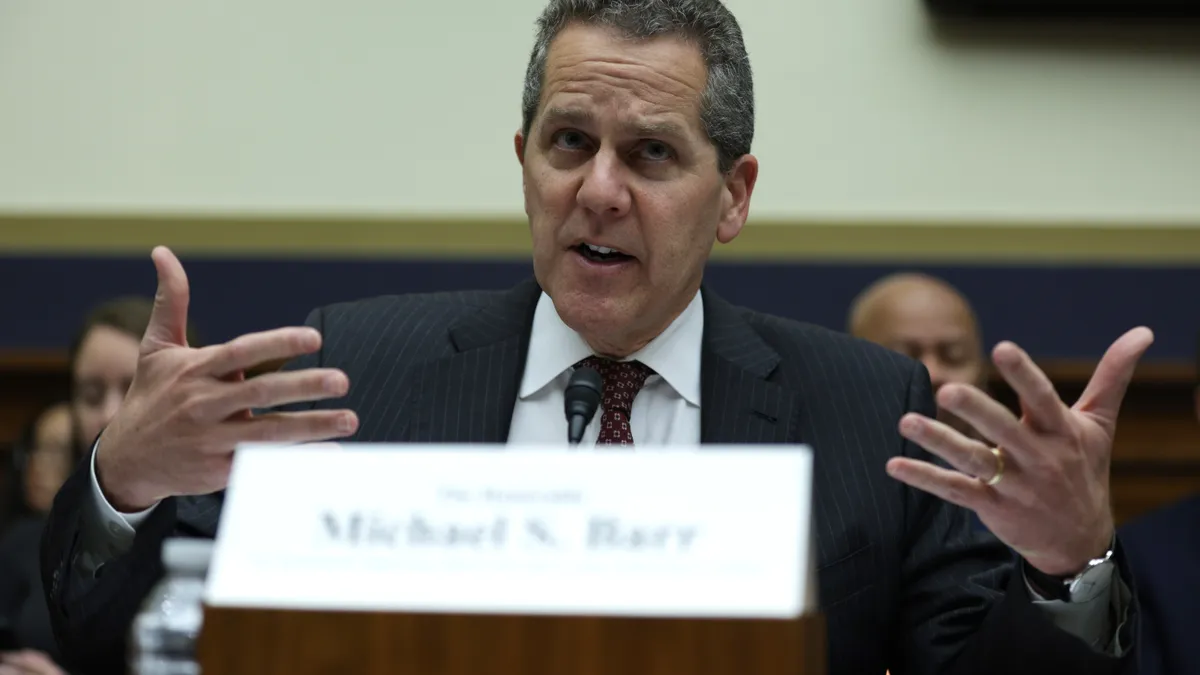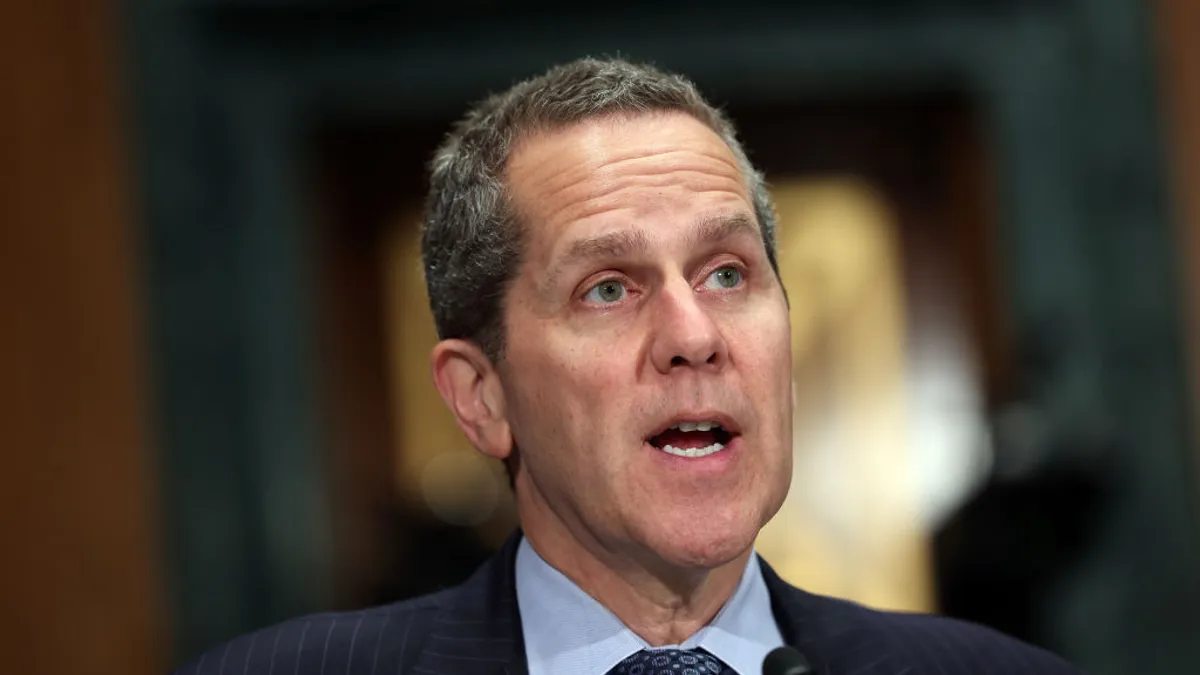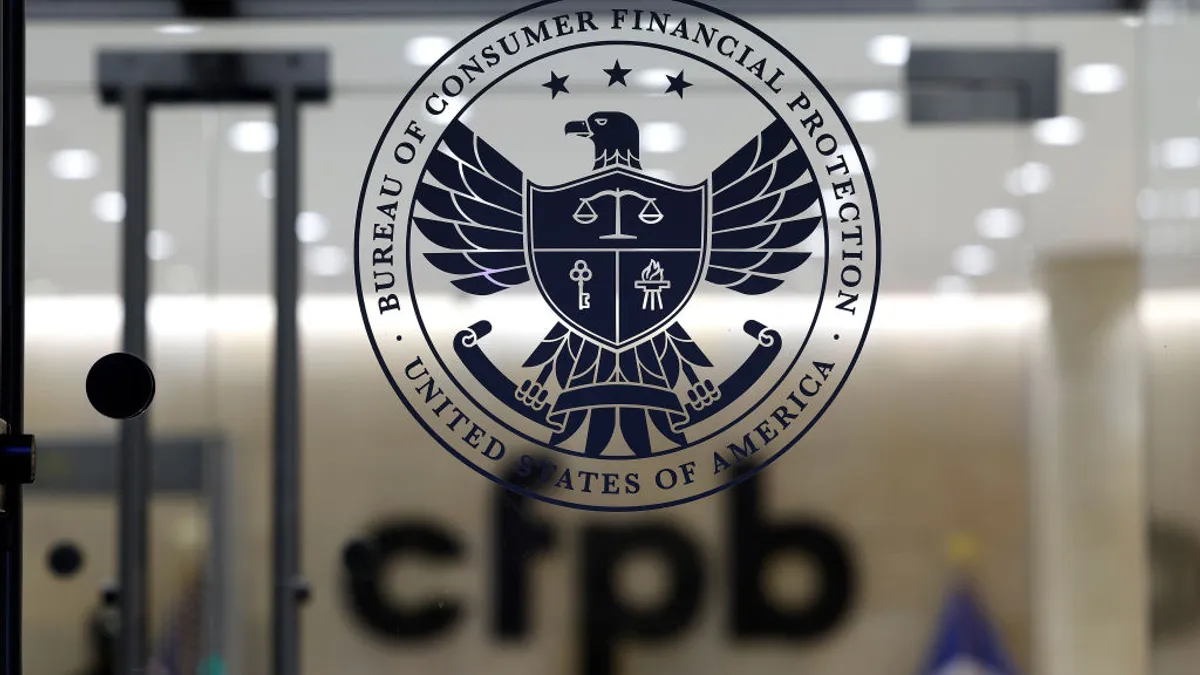All 31 banks participating in the Federal Reserve’s annual stress test have enough capital to endure a scenario in which the U.S. unemployment rate rises by 10%, house prices decline by 36% and commercial real estate prices plunge by 40%, the central bank said Wednesday.
The banks, collectively, would face losses of nearly $685 billion in this year's “severely adverse” scenario — higher than the $541 billion they stood to lose under 2023’s test.
In aggregate, their capital levels fell by an average of 2.8 percentage points — the greatest proportional decline since 3.6 percentage points in 2018. (Last year’s decrease was 2.5 percentage points, by comparison.)
Even under the severe conditions, every tested bank maintained more than the 4.5% minimum capital buffer required in the test — though some banks fared better than others. Charles Schwab, for example, maintained a 25.2% capital ratio under that severe scenario. TD, Deutsche Bank, JPMorgan Chase, BNY, State Street, Northern Trust, Morgan Stanley, Santander and UBS also maintained capital buffers above 10%.
BMO, at 5%, came closest to the minimum, followed by Citizens and HSBC, with 6.5% and 6.7%, respectively.
Deutsche and UBS saw the steepest declines in common equity tier 1 capital from the severely adverse scenario, with the German lender’s buffer dropping — hypothetically — by 13.3 percentage points, and the Swiss bank’s falling by 9.3.
An overestimate?
Still, at least one bank, JPMorgan Chase, said Wednesday night that the Fed overestimated the lender’s “other comprehensive income,” which counts revenues, expenses and losses that are excluded from net income.
“Should the Firm’s analysis be correct, the resulting stress losses would be modestly higher,” the bank said in a statement.
That means it may take more time for JPMorgan to finalize its plans to deliver dividends or repurchase stock, a person with knowledge of the matter told CNBC. The Fed expects banks to wait until after markets close Friday to publicize those plans.
JPMorgan wouldn’t be the first bank to disagree with the Fed over stress test math. The Fed last year projected Bank of America would post $22.3 billion in other comprehensive income over the nine quarters covered by a hypothetical adverse scenario. Bank of America, however, projected $12.5 billion.
Meanwhile, Citi’s internal stress test last year predicted $64.4 billion of non-interest income over nine quarters. The Fed, by contrast, forecast $43.9 billion. By Citi’s calculations, the bank’s capital ratio would have been 10.6%, rosier than the 9.1% the Fed estimated.
“While banks are well-positioned to withstand the specific hypothetical recession we tested them against, the stress test also confirmed that there are some areas to watch,” Michael Barr, the Fed’s vice chair for supervision, said in a statement Wednesday. “The financial system and its risks are always evolving, and we learned in the Great Recession the cost of failing to acknowledge shifting risks.”
Barr pinned the increase in hypothetical losses this year on higher credit card balances and delinquencies, riskier corporate credit portfolios and lower net income stemming from higher costs and decreased fee revenue. The combination “suggest[s] required capital buffers should be larger,” Barr said.
Speedy responses
The stress test sparked speedy responses from the Financial Services Forum and the American Bankers Association, among others.
The results “affirm that the additional capital requirements in the Basel III Endgame proposal are not justified,” Kevin Fromer, FSF’s CEO, said in a statement Wednesday.
"The continued strength and resilience of the banking sector is further evidence that the recent tsunami of new regulation, including proposed higher capital standards, is unwarranted," ABA CEO Rob Nichols said in a statement.
A Fed official told The New York Times the stress test results will not change the central bank’s plans to implement revamped capital requirements for the U.S.’s largest banks.
Hedge funds, credit cards and CRE
Wednesday’s stress test posed an additional challenge for eight of the largest banks participating: Under an “exploratory analysis” in which five large hedge funds implode, the eight banks would lose $70 billion to $85 billion, the Fed found.
Credit card delinquencies, meanwhile, would account for $175 billion in theoretical losses to the larger field of 31 banks, the test found.
Ally would see the largest losses of any of the tested banks on credit cards, at 40.6%. Goldman Sachs, by comparison, would see 25.4%; Capital One, 23.2%; and Discover, 20.3%.
Tested banks would see $142 billion in losses from commercial and industrial loans, the Fed found. Losses from CRE loan books would total $77 billion under the test. Goldman Sachs, at 15.9%, saw the greatest CRE losses among tested banks, followed by Royal Bank of Canada, Capital One and Northern Trust, with 15.8%, 14.6% and 13%, respectively.
“We are positively surprised with the results as we expected losses to be slightly higher compared to the last few years, especially in areas such as commercial real estate," Chris Marinac, director of research at Janney Montgomery Scott, said in a note seen by Reuters.
“In a lot of respects, there should be a sense of comfort that banks can weather a very nasty storm,” he added. "This doesn’t mean the Fed thinks commercial real estate is out of the woods. It’s still early innings in this credit cycle.”
Matthew Bisanz, a partner in the financial services practice at law firm Mayer Brown, said the stress tests’ reliance on capital buffers makes them “unrealistic.”
“All 31 of these banks survive a stress event that lasts nine quarters,” Bisanz told the Financial Times. “[But] last March, we saw three banks obliterated in one month.”






















